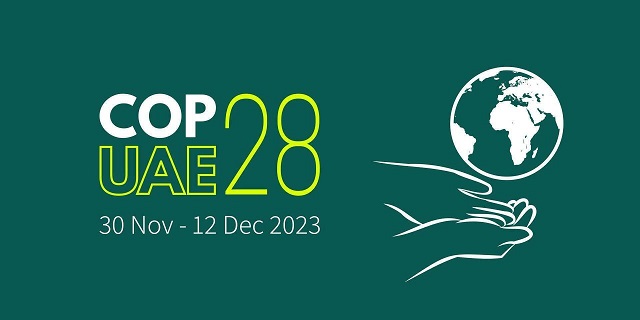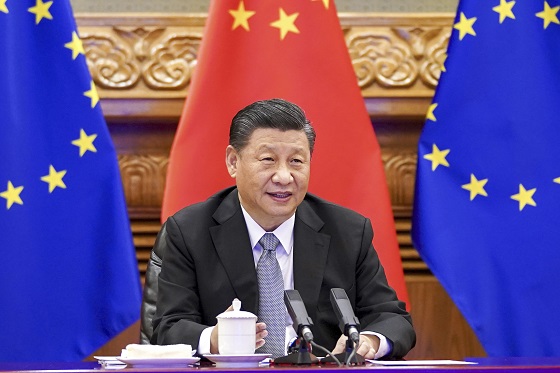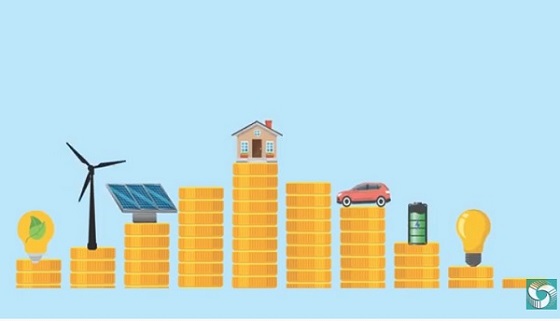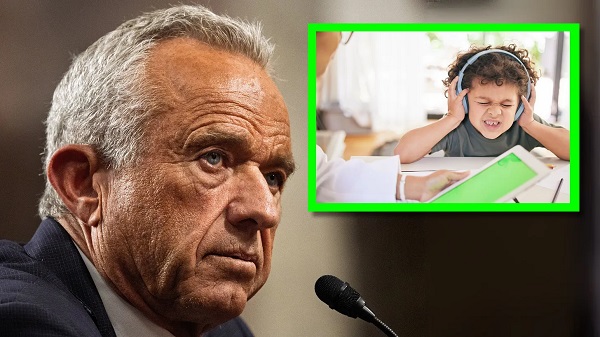Economy
FLOP28 – Climate proposals would devastate economy

From the Frontier Centre for Public Policy
By Ian Madsen
” Most CO2 comes from natural sources like forest fires, volcanoes and ocean evaporation – not your SUV or natural gas furnace. The human portion of this tiny amount is the equivalent of 6 pennies in a jar of 10,000. “
Politicians, academics, celebrities, self-appointed activists, protesters, and green energy industry lobbyists recently gathered in Dubai at their annual Climate Crisis jamboree (COP28). Their central belief, from their computer models, is that human-generated global warming will lead to a rise in average global temperatures of two degrees Celsius, ‘2 C’ or even more frighteningly, as much as 3 C to 4 C by 2100. They claim that this will cause widespread health, environmental, and economic devastation.
From this hypothesis comes their solution: drastic reductions in so-called greenhouse gas emissions, principally carbon dioxide, ‘CO2’, and rapidly so. To their minds, this would require widespread adoption of their preferred solutions – ending fossil fuels in favour of wind and solar power; pervasive and intensive electrification of the world economy, including the mandated adoption of electric vehicles, ‘EVs’, and batteries, everywhere.
They insist that slashing CO2 levels will not only benefit the world, but also the economy – as these new industries would provide jobs and other benefits.
The hard reality is that CO2, is a life-giving gas that is crucial for photosynthesis and thus the flourishing of all life on Earth. It is a trace gas – making up only .04% of our atmosphere. Most CO2 comes from natural sources like forest fires, volcanoes and ocean evaporation – not your SUV or natural gas furnace. The human portion of this tiny amount is the equivalent of 6 pennies in a jar of 10,000. Very awkwardly, CO2 levels in the atmosphere are uncorrelated with temperatures. It may look so in government computer models, but remember those catastrophically wrong Covid models that gave us devastating lockdowns, failed vaccines and exploding debt and inflation?
Even if we assume that CO2 is “pollution that is warming the planet” their wild proposals’ math doesn’t work out.
Professor Richard Tol of the University of Sussex, United Kingdom, wrote in a special issue of Climate Economics a sobering assessment of the ‘bad deal’ climate crusaders are trying to sell to the world, including Canada. He estimates their proposed climate policies’ costs to be 3.8 to 5.6% of GDP in 2100 compared to benefits of 2.8% to 3.2% of GDP – or excess costs of $900 billion to $1.98 trillion in today’s $90 trillion world economy.
The prohibitively large subsidies required fail the cost benefit test. To summarize: Tol suggests that the whole Green Transition ‘enterprise’ would lose money – in vast amounts. His view is not even the worst assessment of such radical disruptive policies.
Another expert who engages the “CO2 is pollution” bubble and has done the math is Bjorn Lomborg, president of the Copenhagen Consensus think tank and a Hoover Institution Senior Fellow.
He assesses MIT researchers’ studies of the costs of attaining Net Zero (no net GHG emissions) by 2050, in the same journal, Climate Economics, and observes that these Paris policies would cost 8% to 18% of annual GDP by 2050 and 11% to 13% annually by 2100…. Averaged across the century, these promises would create benefits worth $4.5 trillion (in 2023 dollars) annually: “dramatically smaller than the $27 trillion annual cost that Paris promises would incur, as derived from averaging the three cost estimates from the two Climate Change Economics papers through 2100.”
To remove any doubt, these forecast costs would exceed total global annual capital investment of all kinds, and would crowd out everything else, impoverishing all humanity. Expensive, destructive ‘solutions’, for a dubious, unproven catastrophe.
The Dubai COP28 flopped as all others have.
We need to stop the madness.
Ian Madsen is the Senior Policy Analyst at the Frontier Centre for Public Policy
Business
Trump: China’s tariffs to “come down substantially” after negotiations with Xi

 MxM News
MxM News
Quick Hit:
President Trump said the 145% tariff rate on Chinese imports will drop significantly once a deal is struck with Chinese President Xi Jinping, expressing confidence that a new agreement is on the horizon.
Key Details:
- Trump said the current 145% tariff rate on China “won’t be anywhere near that high” after negotiations.
- He pointed to his relationship with Xi Jinping as a reason for optimism.
- The White House said it is preparing the groundwork for a deal, and Treasury officials expect a “de-escalation” of the trade war.
Diving Deeper:
President Donald Trump on Tuesday told reporters that the steep tariff rate currently imposed on Chinese imports will come down substantially after his administration finalizes a new trade deal with Chinese President Xi Jinping. While the current level stands at 145%, Trump made clear that number was temporary and would be adjusted following talks with Beijing.
“145 percent is very high. It won’t be that high, it’s not going to be that high … it won’t be anywhere near that high,” Trump said from the Oval Office, signaling a shift once a bilateral agreement is reached. “It will come down substantially, but it won’t be zero.”
The tariff, which Trump previously described as “reciprocal,” was maintained on China even after he delayed similar penalties on other trading partners. Those were cut to 10% and paused for 90 days to allow room for further negotiation.
“We’re going to be very nice. They’re going to be very nice, and we’ll see what happens. But ultimately, they have to make a deal because otherwise they’re not going to be able to deal in the United States,” Trump said, reinforcing his view that the U.S. holds the leverage.
Trump’s remarks come as markets remain wary of ongoing trade tensions, though the White House signaled progress, saying it is “setting the stage for a deal with China.” The president cited his personal rapport with Xi Jinping as a key factor in his confidence that an agreement can be reached.
“China was taking us for a ride, and it’s not going to happen,” Trump said. “They would make billions a year off us and build up their military with our money. That’s over. But we’ll still be good to China, and I think we’ll work together.”
Treasury Secretary Scott Bessent also said Tuesday that he expects a cooling of trade hostilities between the two nations, according to several reports from a private meeting with investors.
As the 90-day pause on other reciprocal tariffs nears its end, Trump emphasized that his team is prepared to finalize deals quickly. “We’ve been in talks with many, many world leaders,” he said, expressing confidence that talks will “go pretty quickly.”
White House Press Secretary Karoline Leavitt added that the administration has received 18 formal proposals from other countries engaged in trade negotiations, another sign that momentum is building behind Trump’s broader push to restructure global trade in favor of American workers and businesses.
(Li Xueren/Xinhua via AP)
2025 Federal Election
Next federal government should end corporate welfare for forced EV transition

From the Fraser Institute
By Tegan Hill and Jake Fuss
Corporate welfare simply shifts jobs and investment away from other firms and industries—which are more productive, as they don’t require government funding to be economically viable—to the governments’ preferred industries and firms, circumventing the preferences of consumers and investors. And since politicians spend other people’s money, they have little incentive to be careful investors.
General Motors recently announced the temporary closure of its electric vehicle (EV) manufacturing plant in Ontario, laying off 500 people because its new EV isn’t selling. The plant will shut down for six months despite hundreds of millions in government subsides financed by taxpayers. This is just one more example of corporate welfare—when governments subsidize favoured industries and companies—and it’s time for the provinces and the next federal government to eliminate it.
Between the federal government and Ontario government, GM received about $500 million to help fund its EV transition. But this is just one example of corporate welfare in the auto sector. Stellantis and Volkswagen will receive about $28 billion in government subsidies while Honda is promised $5 billion.
More broadly, from 2007 to 2019, the last pre-COVID year of data, the federal government spent an estimated $84.6 billion (adjusted for inflation) on corporate welfare while provincial and local governments spent another $302.9 billion. And crucially, these numbers exclude other forms of government support such as loan guarantees, direct investments and regulatory privileges, so the actual cost of corporate welfare during this period was much higher.
Of course, politicians claim that corporate welfare benefits workers. Yet according to a significant body of research, corporate welfare fails to generate widespread economic benefit. Think of it this way—if the businesses that received subsidies were viable to begin with, they wouldn’t need government support. So unprofitable companies are kept in business through governments’ support, which can prevent resources, including investment and workers, from moving to profitable companies, hurting overall economic growth.
Put differently, rather than fuelling economic growth, corporate welfare simply shifts jobs and investment away from other firms and industries—which are more productive, as they don’t require government funding to be economically viable—to the governments’ preferred industries and firms, circumventing the preferences of consumers and investors. And since politicians spend other people’s money, they have little incentive to be careful investors.
Governments also must impose higher tax rates on everyone else to pay for corporate welfare. In turn, higher tax rates discourage entrepreneurship and business investment—again, which fuels economic growth. And the higher the tax rates, the more economic activity they discourage.
GM’s EV plant shut down once again proves that when governments try to engineer the economy with corporate welfare, workers will ultimately lose. It’s time for the provinces and the next federal government—whoever it may be—to finally put an end to this costly and ineffective policy approach.
-

 2025 Federal Election2 days ago
2025 Federal Election2 days agoOttawa Confirms China interfering with 2025 federal election: Beijing Seeks to Block Joe Tay’s Election
-

 COVID-192 days ago
COVID-192 days agoNearly Half of “COVID-19 Deaths” Were Not Due to COVID-19 – Scientific Reports Journal
-

 2025 Federal Election2 days ago
2025 Federal Election2 days agoHow Canada’s Mainstream Media Lost the Public Trust
-

 2025 Federal Election1 day ago
2025 Federal Election1 day agoBREAKING: THE FEDERAL BRIEF THAT SHOULD SINK CARNEY
-

 2025 Federal Election2 days ago
2025 Federal Election2 days agoPOLL: Canadians want spending cuts
-

 2025 Federal Election20 hours ago
2025 Federal Election20 hours agoMark Carney Wants You to Forget He Clearly Opposes the Development and Export of Canada’s Natural Resources
-

 John Stossel2 days ago
John Stossel2 days agoClimate Change Myths Part 2: Wildfires, Drought, Rising Sea Level, and Coral Reefs
-

 2025 Federal Election1 day ago
2025 Federal Election1 day agoCHINESE ELECTION THREAT WARNING: Conservative Candidate Joe Tay Paused Public Campaign







